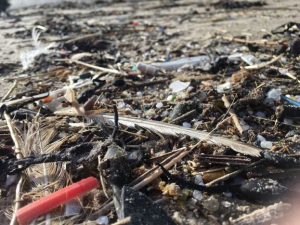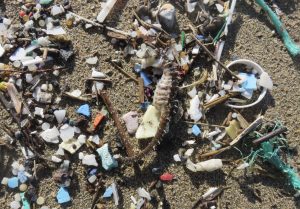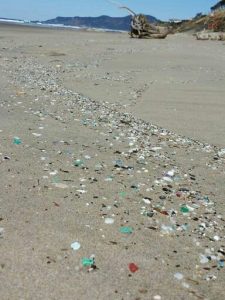From the highest mountain ranges1 to the deepest marine ecosystems on the planet2 plastics are everywhere. Fidra’s own research into nurdle distribution shows that plastic pellets have been found on the shorelines of almost every continent in the world3.
When we started the Great Nurdle Hunt we already knew that nurdles were found in the stomachs of seabirds, and that they could be associated with harmful chemicals – plenty to show us that these pellets didn’t belong in the oceans! Since then, research into microplastic pollution has rapidly advanced. So what has changed in our understanding of microplastics and their impacts in recent years and should we continue to be worried about them?

Photo Credit: Cathy M, Marine litter and plastic in Portmarnock Ireland, (Taken from The Great Global Nurdle Hunt 2019)
Impacts of microplastics on marine ecosystems
A study has estimated that 79% of all plastic ever produced has ended up in landfill or the environment, oceans are considered plastic’s final sink. All plastic that enters the ocean will break up and eventually become microplastics. It is predicted that microplastics now make up 94% of the 1.8 trillion particles that make up the Great Pacific Garbage Patch4 and other recent research has shown there is 14 million metric tons of microplastics on the ocean floor (35 times more plastic than that found on the surface)5. Due to their small size microplastics can be easily ingested by a range of marine animals with fish and seabirds confusing plastic with food6.
Eating Plastic
Ingesting microplastics pose several threats to marine animals. Microplastics can build up in digestion tracks leading some animals to not eat enough real food with proper nutritional value to survive. This has been shown in species of fish7 , baby turtles8and has been particularly damaging to seabirds, with one study showing that microplastics can also directly enter the livers of seabirds causing harm9.
Microplastics can cause abrasions to internal tissues of animals when they ingest them, which can lead to bacteria building up causing further harm to animals. Worryingly this has been shown to happen in important keystone species (certain species that are critical to the survival of the other species in an ecosystem10) such as red coral that support vital and fragile tropical reef ecosystems11.
Chemical Contaminants
Another concern with microplastics that scientists are only just beginning to understand is the negative effects from chemicals associated with plastic. Microplastics acquire chemicals in three ways – firstly most plastic is made of fossil fuels which can contain harmful contaminants, secondly chemical additives are used to give plastic colour or to make the plastic “bendy”.

Photo credit: Tracey Williams, Seahorse amongst plastic and nurdles
For example, rubber crumb from artificial football pitches is a type of microplastic that has been found to leach out heavy metals, endocrine disrupters (substances that interfere with how our hormones function e.g., phthalates) and carcinogens (e.g., PAHs) into the surrounding environment. A recent study found 197 chemicals out of 306 identified in a sample of rubber crumb met the carcinogenicity criteria12.
Thirdly, plastics have been shown to adsorb chemical contaminants once in the environment, including persistent organic pollutants (POPs) and metals. We‘ve known about this effect on nurdles, but research in the last few years shows that the ability to absorb contaminants increased as microplastic particles get smaller, and as they become weathered with age13.
Whether these chemicals are absorbed into the body of animals and cause harm depends on how long they stay in the animal for. Nevertheless, several studies are starting to show proof of absorption of these chemicals into animal tissue and associated negative impacts. For example, a study showed seabass that were fed food containing contaminants of microplastics accumulated the contaminants in their tissues in high concentrations after forty days14. Other studies have shown chemicals from tyre rubber can be deadly to salmon 15 and cause harm to other marine animals such as mussels16.
Spreading disease and invasive species
As well as transporting harmful chemicals throughout the world’s oceans, microplastics can also act as a vector for biological contaminants. For example, studies have shown that harmful species of algae have been found to colonise microplastics17. A recent study in Scotland also demonstated that nurdles at five public beaches had been colonised by E.coli18. This poses a great risk of microplastics being an ideal vector to transport invasive microorganisms far and wide and is another reminded of the importance of hygiene when handling nurdles and other marine litter.
Are microplastics harming humans?

Photo Credit: Jill Marks, Microplastics on Schooner South Beach, Newport, US (The Great Global Nurdle Hunt 2020)
Due to plastics widespread prevalence and potential toxicity, there are increasing concerns around human health impacts. Studies have recently predicted humans could be ingesting up to 52,000 microplastic particles every year through contaminated food and these estimates increase to 121,000 particles when inhalation of microplastics is considered19, 20, 21.
Up until now, it has been estimated that the quantity of microplastics consumed by humans has been too little to cause significant harm. However, scientists are becoming increasingly concerned about nano plastics (plastics less than 1 μm in size, equivalent to the size of a typical bacterium) and their potential to enter human cells disturbing cellular activity.
This has been shown in a recent study which exposed lung cells to polystyrene micro and nano plastics at concentrations ranging from that experienced by residents of urban areas, to the higher concentrations workers at industrial manufacturing sites may experience. The cells were found to display major
changes and multiple nanoplastics were found to enter the cells22. Overall, research shows microplastics do not endanger short-term health except at high concentrations like that of workers in industrial settings. However, recent studies suggest long term exposure to microplastic inhalation has significant potential to harm humans.
Why we must act now
Microplastics are threatening whole ecosystems and are becoming of increasing concern for human health. Plastic production is increasing, a recent study predicts the amount of plastic ending up in our oceans is to triple by 2040 to 23-37 million metric tons per year23. Additionally, current estimates of marine microplastic concentrations are predicted to be vastly underestimated24. We must act now to reduce the amount of microplastics entering the environment. There are many ways we can cut down on microplastic pollution and you can be part of the solution. Why not start by taking part in one of Fidra’s projects tackle microplastic pollution?
- Join the Great Global Nurdle hunt this October to track plastic pellet pollution and hold industry to account. Find out more about this by heading to: www.nurdlehunt.org.uk
- Tackle microplastic pollution from artificial football pitches in your local area. Find out more about this problem and resources to use at: www.fidra.org.uk/artificial-pitches
References
- Napper, Imogen E., et al. 2020. Reaching new heights in plastic pollution—preliminary findings of microplastics on Mount Everest. One Earth 3.5: 621-630.
- Jamieson, Alan J., et al. 2019. Microplastics and synthetic particles ingested by deep-sea amphipods in six of the deepest marine ecosystems on Earth. Royal Society open science 6.2.: 180667.
- Fidra, 2019. The Great Nurdle Hunt. [Online] Available at: https://www.nurdlehunt.org.uk/nurdle-finds.html (Accessed 8th April 2021).
- Lebreton, L., Slat, B., Ferrari, F., Sainte-Rose, B., Aitken, J., Marthouse, R., … & Reisser, J. (2018). Evidence that the Great Pacific Garbage Patch is rapidly accumulating plastic. Scientific reports, 8(1), 1-15.
- Barrett, J., Chase, Z., Zhang, J., Holl, M. M. B., Willis, K., Williams, A., … & Wilcox, C. (2020). Microplastic Pollution in Deep-Sea Sediments From the Great Australian Bight. Frontiers in Marine Science, 7, 808.
- Savoca, M. S., Wohlfeil, M. E., Ebeler, S. E., and Nevitt, G. A. (2016). Marine plastic trash emits a keystone infochemical for olfactory foraging seabirds. Science Advances 2:e1600395.
- Jovanović, B. (2017). Ingestion of microplastics by fish and its potential consequences from a physical perspective. Integrated environmental assessment and management, 13(3), 510-515.
- Eastman, C. B., Farrell, J. A., Whitmore, L., Rollinson Ramia, D. R., Thomas, R. S., Prine, J., … & Duffy, D. J. (2020). Plastic ingestion in post-hatchling sea turtles: assessing a major threat in Florida near shore waters. Frontiers in Marine Science, 7, 693.
- Roman, L., Hardesty, B. D., Hindell, M. A., & Wilcox, C. (2019). A quantitative analysis linking seabird mortality and marine debris ingestion. Scientific reports, 9(1), 1-7.
- https://www.nationalgeographic.org/encyclopedia/keystone-species/
- Corinaldesi, C., Canensi, S., Dell’Anno, A., Tangherlini, M., Di Capua, I., Varrella, S., & Danovaro, R. (2021). Multiple impacts of microplastics can threaten marine habitat-forming species. Communications biology, 4(1), 1-13.
- Perkins, AN, Inayat-Hussain, SH, Deziel, NC, et al. Evaluation of potential carcinogenicity of organic chemicals in synthetic turf crumb rubber. Environ Res 2019; 169: 163–172.
- Yu, F., Yang, C., Zhu, Z., Bai, X., & Ma, J. (2019). Adsorption behavior of organic pollutants and metals on micro/nanoplastics in the aquatic environment. Science of the Total Environment, 694, 133643.
- Granby, K., Rainieri, S., Rasmussen, R. R., Kotterman, M. J., Sloth, J. J., Cederberg, T. L., … & Larsen, B. K. (2018). The influence of microplastics and halogenated contaminants in feed on toxicokinetics and gene expression in European seabass (Dicentrarchus labrax). Environmental research, 164, 430-443.
- Tian, Z., Zhao, H., Peter, K. T., Gonzalez, M., Wetzel, J., Wu, C., … & Kolodziej, E. P. (2021). A ubiquitous tire rubber–derived chemical induces acute mortality in coho salmon. Science, 371(6525), 185-189.
- Capolupo, Marco, et al. 2021. The sub-lethal impact of plastic and tire rubber leachates on the Mediterranean mussel Mytilus galloprovincialis. Environmental Pollution: 117081.
- Casabianca, S., Capellacci, S., Giacobbe, M. G., Dell’Aversano, C., Tartaglione, L., Varriale, F., … & Penna, A. (2019). Plastic-associated harmful microalgal assemblages in marine environment. Environmental Pollution, 244, 617-626.
- Rodrigues, A., Oliver, D. M., McCarron, A., & Quilliam, R. S. (2019). Colonisation of plastic pellets (nurdles) by E. coli at public bathing beaches. Marine pollution bulletin, 139, 376-380.
- Cox, K. D., Covernton, G. A., Davies, H. L., Dower, J. F., Juanes, F., & Dudas, S. E. (2019). Human consumption of microplastics. Environmental science & technology, 53(12), 7068-7074.
- Gasperi, J., Wright, S. L., Dris, R., Collard, F., Mandin, C., Guerrouache, M., … & Tassin, B. (2018). Microplastics in air: are we breathing it in?. Current Opinion in Environmental Science & Health, 1, 1-5.
- Smith, M.; Love, D.C.; Rochman, C.M.; Neff, R.A. (2018). Microplastics in Seafood and the Implications for Human Health. Curr. Environ. Health Rep.5, 375–386.
- Goodman, K. E., Hare, J. T., Khamis, Z. I., Hua, T., & Sang, Q. X. A. (2021). Exposure of Human Lung Cells to Polystyrene Microplastics Significantly Retards Cell Proliferation and Triggers Morphological Changes. Chemical Research in Toxicology, 34(4), 1069-1081.
- The Pew Charitable Trusts, 2020. Breaking the Plastic Wave, A comprehensive assessment of pathways towards stopping ocean plastic pollution. Available: breakingtheplasticwave_mainreport.pdf (pewtrusts.org). (accessed 8th April 2021).
- Lindeque, Penelope K., et al. 2020. Are we underestimating microplastic abundance in the marine environment? A comparison of microplastic capture with nets of different mesh-size. Environmental Pollution 265: 114721.
Tags: marine litter, microplastics, nurdles, plastic pollution, rubber crumb
